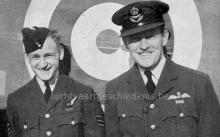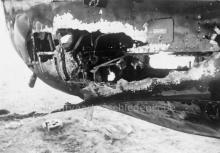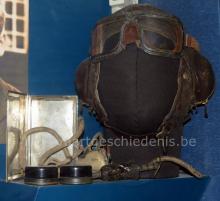De Schotse John Hannah was slechts 18 jaar oud toen hij als boordschutter/radiotelegrafist boven Antwerpen hing, aan boord van zijn Hampden P1355 om de haven te bombarderen. Een flakgranaat ontplofte in de buurt en zette het toestel in lichterlaaie. Twee van de vier bemanningsleden besloten het vege lijf te redden en sprongen, maar Hannah begon het vuur te doven. Hij spoot twee brandblussers leeg, bekampte met zijn handen de vlammen, allemaal in de hoop dat de bomlading niet zou ontploffen. Uiteindelijk lukte het hem toch, en hij kroop bij zijn piloot, Pilot Officer Connor, die het toestel terug naar de basis bracht.
Na de landing rapporteerde de gezagvoerder over de uitzonderlijke moed van zijn boordschutter, en dit leidde uiteindelijk tot de toekenning van het Victoria Cross, de hoogte Britse militaire onderscheiding. De piloot kreeg het DFM uitgereikt. Bekijk zeker het filmpje dat gedraaid werd nadat beiden hun onderscheiding kregen - klik hier.
John Hannah blijft de jongste vliegenier die ooit het VC kreeg, en de jongste van WO 2. Hij bezweek in 1947 aan tuberculose. Zijn Victoria Cross, alsook zijn geblakerde vlieghelm en tabaksdoos, liggen tentoongesteld in het RAF Museum te Hendon.
Uit The Londen Gazette:
"The KING has been graciously pleased to confer the VICTORIA CROSS on the undermentioned officer in recognition of most conspicuous bravery :-
652918 Sergeant John Hannah :-
On the night of 15th September, 1940, Sergeant Hannah was the wireless operator/air gunner in an aircraft engaged in a successful attack on an enemy barge concentration at Antwerp. It was then subjected to intense anti-aircraft fire and received a direct hit from a projectile of an explosive and incendiary nature, which apparently burst inside the bomb compartment.
A fire started which quickly enveloped the wireless operators and rear gunners cockpits, and as both the port and starboard petrol tanks had been pierced, there was grave risk of the fire spreading. Sergeant Hannah forced his way through to obtain two extinguishers and discovered that the rear gunner had had to leave the aircraft. He could have acted likewise, through the bottom escape hatch or forward through the navigators hatch, but remained and fought the fire for ten minutes with the extinguishers, beating the flames with his log book when these were empty.
During this time thousands of rounds of ammunition exploded in all directions and he was almost blinded by the intense heat and fumes, but had the presence of mind to obtain relief by turning on his oxygen supply. Air admitted through the large holes caused by the projectile made the bomb compartment an inferno and all the aluminium sheet metal on the floor of this airmans cockpit was melted away, leaving only the cross bearers.
Working under these conditions, which caused burns to his face and eyes, Sergeant Hannah succeeded in extinguishing the fire. He then crawled forward, ascertained that the navigator had left the aircraft, and passed the latter's log and maps to the pilot. This airman displayed courage, coolness and devotion to duty of the highest order and by his action in remaining and successfully extinguishing the fire under conditions of the greatest danger and difficulty, enabled the pilot to bring the aircraft to its base."
Antwerpen
be


